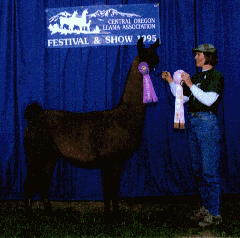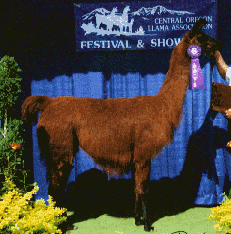Llama care, management and resources
- Llama FAQ
- Llama literature
- Basic care
- Castration
- Spaying
- About breeding llamas
- Handling young llamas
- Misdirected territorial aggression
- How old should llamas be for training and work?
- Performance classes
- Halter classes
Fiber from llamas
Llamas
as guardians
Classic performance llamas
Communicating
Our llama family
Just for fun
Cria photos
Training consultation
Performance
llama analysis
If you don't rescue ... DON'T BREED!
If you don't rescue ... DON'T BREED!
Showing -- Halter Classes
Halter classes are supposed to judge the llama on conformation, but conformation is a group of task-specific criteria and halter classes have no such designation. In fact, the halter class rules actually require that the llamas be judged on "eye appeal!" Success at halter is usually transitory, but certainly exciting while it lasts ... if you can get past the reality that the judges are only picking what appeals to them, not which llamas are likely to excel at a specific use (in fact, the very best pack llamas rarely place well at halter).
Sanctioned shows divide breeding llamas into male and female, each usually with four age groups (5-12 months, 13-24 months, 25-36 months, and 37+ months). The very young age divisions that stop before llamas even physically mature is a direct reflection of standard practice -- use 'em as young as possible and get rid of them before they get enough confidence to object to rotten or cruel handling. There are now usually at least three and sometimes four wool divisions. Coat type is not considered (except for "suri" fleeced llamas), and Classic llamas are frequently at a distinct disadvantage due to show associations encouraging shows to combine the Classic llamas withe the "light wool" division, and judges rewarding shorn and nonshedding crossbreds with Classic class ribbons intead of removing them to the appropriate wool division.
Geldings and spays are currently lumped together (sexes are not separated, believe it or not!), given three age groups, no wool divisions, and no guidelines as to judging criteria.
In all halter classes, handlers are asked their llamas' ages, and the answers may have either appropriate or prejudicial impact on final placings. We've experienced both.
Champions and Reserve Champions are usually given for the males and females in each wool division, and to the geldings.
Because halter awards are based on constantly-changing fashion, people who breed specifically for halter class are one of the two largest reasons there are so many unwanted llamas today. Please don't mistake our few halter awards for any kind of endorsement of these classes, or of the irresponsible practice of breeding llamas for halter classes!

Snake
River Dallys (with Gwen)
(photo by Diana Pyle)

(photo by Diana Pyle)
Progeny Classes
These are also supposed to be judged on conformation (for no particular purpose) and additionally on uniformity of the entries. In practice, uniformity of sihouette and quantity of wool weigh heaviest in placements. Unlike progeny classes at dog shows, the sire or dam is not shown with his or her offspring, and thus might be completely unlike the entries, which certainly does not support the purported purpose of identifying "prepotent" breeding stock.
Get-of-sire entries must have three offspring of the same stud (entries must represent at least two different dams); produce-of-dam entries must have two offspring of the same female (there are no restrictions on the sires of the entries). In both cases, all progeny must also be entered in their appropriate halter classes. You can see that these classes are not for those whose llama showing is on a budget.
Wins in progeny classes are required to achieve the highest ALSA cumulative awards unless the llama in question has been neutered. Unfortunately, female llamas are currently rather expensive to spay, so owners of nonbreeding females are effectively prevented from ever earning those awards; additionally, llamas of both sexes who should not be breeding are thus encouraged to breed -- a LOT. Operators of cria mills who like to win at shows generate vast numbers of babies each year in order to have a better chance of getting two or three fashionable look-alikes -- not a healthy practice when the not-so-trendy, no-purpose llama "market" is more than saturated already.
Showmanship
Showmanship classes judge the ability of the handler to work the llama on halter in simple patterns and tasks within established tradition. Grooming is also judged, and often a question about llamas is asked.
Although the original purpose of showmanship competitions was to give handlers judged feedback on their halter class showing skills, the current scope has expanded well beyond that, and the desired actions in showmanship have even deviated notably from preferred halter showing techniques.
Exhibitors tend to either love showmanship or hate it. Adults are usually separated from the youth, who may have two age divisions. Many shows do not offer adult showmanship.
Return to Showing Llamas
Return to Lost Creek Llamas home page